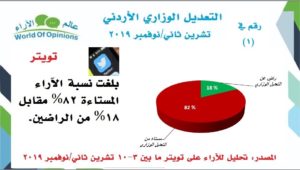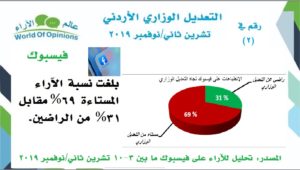Measuring opinions in social media about the fourth ministerial reshuffle of the Omar Razzaz government
As part of the program to analyze public opinion through social media networks, and under supervision of Dr. Samir Abu Rumman, the Opinion World Center for Opinion Polls issued its report on Jordanians’ reaction to the ministerial reshuffle of the government of Dr. Omar Al-Razzaz through automated analysis of the opinions contained in comments and tweets published on social media (Twitter/Facebook), which the center implemented during the period between 3-10 November.
The sample included 1,150 comments and 1,500 tweets extracted from Twitter and Facebook during the time period between November 3-10; Which came as a reaction to the new ministerial reshuffle. The fact that social media networks have become a platform for some of the Jordanian political elites included in the study was taken into account. Accordingly, the official accounts representing those parties were excluded, to ensure the neutrality of the sample studied and to avoid misleading public opinion.

Opinion analysis was carried out using software specially developed for the Opinion World Center, which represents a model based on machine learning, natural language processing techniques, and Arabic dialects, including the Jordanian dialect. The study methodology relied on collecting textual information (tweets/comments) published by users on social media, arranging and organizing it, and then analyzing it. To extract opinions and classify them to reflect society’s trends towards the new ministerial reshuffle.

Below we present the most prominent results of the analytical study according to the social media platform studied:
1- Interaction via Facebook:
As a preliminary result, about 1,150 comments were collected, written in response to the publications and statements made to the media by the Prime Minister and some political and societal elites, regarding the ministerial reshuffle, during the period from 3 to 10 November.
It was noted that there was a difference in the rate of publishing regarding the topic studied on Facebook compared to Twitter. The number of comments generated after filtering reached 588 comments, which is approximately four times the size of the sample studied from Twitter.
It was noted that the highest rate of interaction was on November 8; Following the statements made by the Prime Minister to Al-Mamlaka TV on the occasion of the new ministers being sworn in, the percentage of comments reached 59%, while it gradually declined by the end of the week to reach 1% of the total comments.
It is interesting that the distribution of opinions, drawn from the Facebook sample, between those who were satisfied or dissatisfied with the amendment was relatively consistent with the trend of public opinion on Twitter. It was found that the majority of written comments were against the amendment, as the percentage of negative opinions towards the new ministerial formation reached 69%, with a modest increase in the percentage of positive opinions compared to those obtained on Twitter, reaching 31%.
It is worth noting that the number of negative comments dominated the positive ones during the period from November 3 to 10, with a slight increase in the number of positive opinions on November 8 to reach 59.3% of the total positive opinions in the studied sample and 31% of the total comments.
It was also possible to notice a variation in the distribution of percentages of supportive and dissatisfied opinions of the cabinet reshuffle during the time period studied, with the highest percentage of opposing opinions reaching 90% on November 5, as that period witnessed signs of the formation of the government and coincided with a group of leaks and discussions about the nominated figures for the expected government, while The percentage of opinions supporting the cabinet reshuffle began to rise shortly after the official announcement of the new ministerial formation, reaching its highest value of 44% on November 9, when some comments included praise for some of the new ministers and optimism about upcoming promises and achievements.
2- Interaction via Twitter:
The initial tally of collected tweets contained about 1,500 tweets, after applying automatic filtering of irrelevant tweets (ads), and excluding news tweets that do not include opinion content, or that contain only the hashtag, or are retweeted via automated accounts (bots). Or those that include congratulations and congratulations to the new ministers. 165 tweets were approved that contain exclusively opinions related to the new ministerial reshuffle.
According to the sample studied, the peak of tweeting occurred on November 7; The day the new cabinet formation was officially announced, opinion on the cabinet reshuffle was expressed through approximately 62% of all tweets. This is logical, as after announcing the identity of the new ministers, the Twitter platform was full of discussions and interaction was intense regarding the potential new faces in the expected government.
On the other hand, the tweet rate decreased in the following days, reaching its lowest level on November 9 and 10, at a rate of 4%. This is explained by the decline in interest in the issue, especially after it became clear to the Jordanians that some ministerial portfolios were being exchanged between ministers from the previous ministerial formation, in addition to the focus of public opinion on tracking the event of the Kingdom of Jordan’s handing over of the lands of Baqoura and Ghamr.
Regarding the reactions to the new cabinet reshuffle, opinions varied between satisfied and dissatisfied, as by applying a machine learning model trained to understand the Jordanian dialect, the results of the opinion analysis indicated, for the sample studied, that most of the tweets expressed Jordanians’ disappointment in the new ministerial formation, as The total percentage of dissatisfied opinions with the cabinet reshuffle reached 82%, while the percentage of satisfaction with the new government was 18%.
By examining the distribution of tweets for and against the cabinet reshuffle over the past week, it can be seen that the number of tweets opposing the cabinet reshuffle varied, as it reached its peak on November 7, the day of the swearing-in session for the new ministers, at a rate of 51% of the total tweets studied.
On the other hand, the percentage of dissatisfaction with the cabinet reshuffle varied during the period from November 3 to November 8. Its highest percentage was 86.7% on November 4, the day that witnessed the resignations of the ministers of the previous government following the issuance of royal approval for the amendment. While the highest percentage of positive tweets regarding the cabinet reshuffle did not exceed 26.7% and were published on November 8, following the official announcement of the new cabinet formation. Despite the dominance of negative opinions on November 9 and 10, this percentage does not truly reflect public opinion, especially with the spotlight shifting away from the issue, which in turn was reflected in the number of tweets, which did not exceed 12 tweets on these two days.
To download the report in PDF, click the link below:
https://drive.google.com/file/d/18HKyhsohf3JHP7-3oMBTWegA961Ez9BV/view?usp=sharing




